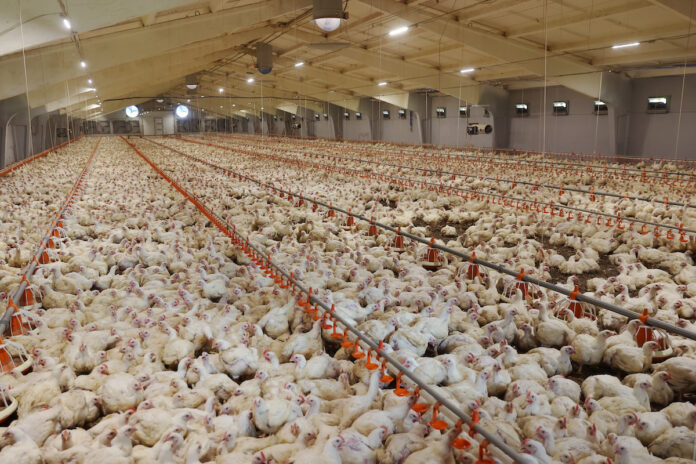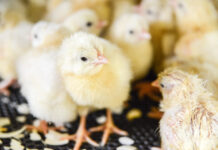
Salmonella remains one of the most important foodborne bacterial pathogens worldwide, and is frequently linked with the consumption of contaminated poultry meat and eggs. Despite some noted successes in reducing particular serotypes and strains, other serotypes have become more problematic. Progress has also been frustrated by increasing resistance to antimicrobials and biocides.
R.J. Atterbury – School of Veterinary Medicine and Science, University of Nottingham, Sutton Bonington, UK
Biological control using bacteriophages or predatory bacteria is an alternative approach to Salmonella control in poultry which has been effective in laboratory, experimental and/or field trial settings. The European Union is currently considering authorizing the first phage-based commercial product for the treatment of Salmonella in poultry. Questions remain about the regulation and commercial status of such products, as well as their long-term efficacy; but their ability to specifically target multidrug resistant bacteria may provide a new way of reducing our reliance on antimicrobials and decrease the burden of disease in both animals and humans in the future.
Introduction
Salmonellosis remains one of the most frequent food-borne zoonoses, constituting a worldwide major public health concern. Although Salmonella can be acquired from a range of foods, poultry meat and eggs remain prominent (Antunes et al., 2016). Human salmonellosis cases in the US are estimated at 1.35 million per year (Centers for Disease Control, 2019). Likewise, cases in the UK and EU have not changed significantly over the past decade.
Success in controlling some Salmonella serotypes (e.g. Enteritidis) in poultry through vaccination and biocontrol have been punctuated by failure to control other serotypes. A recent example of this was an outbreak of Salmonella Infantis in the United States in 2018, affecting 32 states (Centers for Disease Control, 2019). In the EU, Salmonella Infantis is now the 4th most common serotype from human infections, and the most frequent serotype in broilers flocks (45.6 %) and broiler meat (50.6 %) in Europe (Alba et al., 2020). More worryingly, multidrug-resistant isolates are becoming increasingly common in Europe, particularly those which have acquired a pESI megaplasmid encoding resistance to multiple classes of antibiotics as well as virulence genes and enhanced tolerance of heavy metals and biocides (Tyson et al., 2021).
One alternative approach to Salmonella control is the use of biological control agents; either viruses which specifically infect Salmonella – bacteriophages – or use of predatory bacteria such as Bdellovibrio bacteriovorus. In a recent review of alternatives to antibiotics, funded by the Wellcome Trust and UK Department of Health, bacteriophage-based treatments comprised three of the ten Tier 1 (most promising) new technologies (Czaplewski et al., 2016). Although less developed, Bdellovibrio has been used successfully to control infection in multiple animal models of disease, including the treatment of Salmonella in poultry (Atterbury et al., 2011).
Biological control has unique advantages over antimicrobials. These agents are both self-replicating and self-limiting – reproducing only when susceptible bacteria are present. Unlike broad-spectrum antibiotics, they target a specific genus, species or strain of bacterium, avoiding potential harmful dysbiosis in the patient. Likewise, several studies have found that Bdellovibrio can prey upon multidrug resistant pathogens in biofilms (Atterbury and Tyson, 2021; Sun et al., 2017). In addition, Bdellovibrio can survive for up to 24 h inside eukaryotic cells without adverse effects, suggesting that it could be applied to control pathogens with an intracellular component to their lifecycle, including Salmonella (Atterbury and Tyson, 2021).
Method
Candidate therapeutic bacteriophage are usually isolated from an environment where their bacterial hosts are abundant. In the case of Salmonella, this is often poultry feces, wastewater or human sewage. Once purified, these phages are screened against a large panel of target serotypes and strains which should be chosen to reflect the diversity of pathogens affecting the population. Phages that infect a broad range of bacteria, either separately or in combination (cocktail) are usually selected for genome sequencing and analysis. This step allows the identification of undesirable phage e.g. temperate phage which do not underdo a direct and predictable lytic infection cycle. It also identifies phage carrying undesirable genes such as those associated with virulence. More detailed in vitro characterization of the phage may be performed in parallel, such as determining the burst size and replication kinetics of infection. For promising candidates, the specific phage receptor(s) on the host bacterium may be identified, along with an assessment of how frequently resistance to phage occurs.
Increasingly, bioinformatics is being used to facilitate the characterization and selection of phage. There are tools available to predict the taxonomy, DNA packaging mechanisms (Garneau et al., 2017), lifecycle (McNair et al., 2012), receptor specificity and host range (Zhang et al., 2017) of candidate phage. Once a phage is characterized, online tools can be used to compare it with others uploaded to the database which may be useful for cross-validation (Rangel-Pineros et al., 2021). Further confirmatory tests can then be performed in the laboratory, for example to establish the phage receptors predicted in silico. Thereafter, the phage candidates can be tested for efficacy in simple animal models such as Galleria mellonella and their stability in commercial preparations before taking forward to experimental and field trials in poultry.
Bdellovibrio, like phage, is most often isolated from environments where their prey are abundant. This is often in aquatic environments or sewage. Unlike most bacteriophage, Bdellovibrio targets multiple genera of Gram-negative pathogens, and resistance to predation is rare and transient (Marine et al., 2020). There is evidence that Bdellovibrio or like organisms are present in the intestinal tracts of a range of animal species, including poultry (Schwudke et al., 2001). However, these bacteria have been difficult to isolate and exploit directly. Bdellovibrio are metabolically active and chemotactic towards their prey. As such, unlike phage they are not reliant on passive diffusion to spread through a bacterial population. However, it also means the options available for therapeutic delivery are more limited than with phage and commercial preparations may be more challenging.
Results
Salmonella is frequently a target of biological control trials owing both to its importance as a human pathogen and as a cause of significant disease and production losses in livestock. Most effort has been directed towards controlling important non-host-restricted serotypes of Salmonella, such as Enteritidis and Typhimurium which are more significant from a regulatory perspective in the EU and elsewhere.
Cocktails of lytic phage have been used to reduce intestinal carriage of Salmonella by between 1 and 3.5 log10 CFU/g (Atterbury et al., 2007; Sklar and Joerger, 2007). These reductions were often accompanied by marked improvement or elimination of clinical signs of disease (Sklar and Joerger, 2007). Phage therapy has been combined with seeder models of infection to demonstrate how effective phage can be in preventing horizontal infection of chicks by Salmonella. Lim et al. (2012) showed that treatment with up to 109 PFU/g of phage in feed could reduce intestinal colonization by up to 1 log10 CFU/g, while 70% of the contact chickens had no detectable Salmonella Enteritidis colonization. Henriques et al. (2013) significantly reduced the spread of Salmonella Enteritidis in chicks by treating fertilized eggs with a cocktail of two phages. Clinical signs of disease at the end of the eight-day study were not significantly different from the control group.
More recently, two studies have examined the impact of applying therapeutic phage on the chicken microbiome. Kosznik-Kwaśnicka et al. (2022) found that both phage and antibiotics (enrofloxacin and colostin) were all able to reduce Salmonella to below detectable levels in infected chickens. However, antibiotic use was associated with significant and prolonged changes in the microbiome whereas the effects of phage were transient and normalized several weeks after treatment. Similarly, Clavijo et al. (2022) used a proprietary Salmonella phage product in a commercial broiler farm to assess the effect on the gut microbiome. No significant effects of phage on the maturation of the microbiome were detected.
Bdellovibrio has been isolated previously from the intestinal tracts of chickens as well as humans and other vertebrates (Schwudke et al., 2001). Atterbury et al. (2011) used Bdellovibrio to treat chickens experimentally infected with Salmonella Enteritidis. Significant reductions of over 1 log10 CFU/g were recorded in the ceca of treated birds compared with buffer-treated controls. Bdellovibrio-treated birds also had significantly fewer cecal abnormalities compared with both untreated controls and birds treated with a non-predatory Bdellovibrio mutant. Interestingly, in vitro experiments using both phage and Bdellovibrio showed that the combination of both virus and predator was able to eliminate pathogen populations much more effectively than either used independently (Hobley et al., 2020)
Discussion
Bacteriophages have been shown to significantly reduce the intestinal carriage of multiple serotypes of Salmonella in broiler and layer chickens. These reductions were frequently accompanied by improvements in clinical manifestations of disease (reduced perihepatitis, pericarditis, typhlitis) as well as feed conversion ratios. Although phage-resistant variants of Salmonella have been recorded, these phenotypes are often transient, and associated with reduced fitness in animal models of infection. Resistance to Bdellovibrio on the other hand is extremely rare, and only conferred by the presence of an intact S-layer which is metabolically expensive to maintain. Interestingly, when Bdellovibrio and bacteriophage are used in combination, they can act synergistically for a greater reduction in the target pathogen without the development of resistance.
Despite their promise, there remain some technical, commercial and regulatory hurdles which need to be overcome before bacteriophages and Bdellovibrio could be used more widely in the UK/EU. These agents do not fit easily within existing regulatory frameworks which were designed for defined chemotherapeutics. Likewise, the ability to protect intellectual property relating to naturally-occurring biological entities is an open question. Despite these obstacles, commercial phage products targeting food-borne pathogens are available in the United States and the EU is in advanced discussions to authorize the first bacteriophage treatment for livestock in the bloc. Given the pressing need to control multidrug-resistant infections, and the reducing efficacy and availability of antibiotics to treat them, biological control agents such as Bdellovibrio and bacteriophage offer a potential solution.
References are available on request
From the Proceedings of the Australian Poultry Science Symposium 2023
















